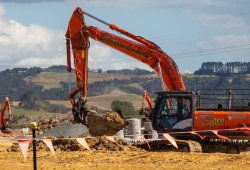New endangered species at risk from coal mining
New endangered species at risk from coal mining
A new species of endangered moth is living on conservation land slated for an open-cast coal mine.
The Avatar moth lives on the Denniston Plateau and is so threatened by coal mining related habitat destruction it has been classified as nationally critical.
Photos of the Avatar moth can be found here.
“It’s so urgent the Government fulfils its promise to end mining on conservation land,” says Debs Martin, Forest & Bird top of the south Regional Manager.
A single specimen of the moth was discovered by entomologist Brian Patrick during a Forest & Bird bioblitz in 2012. Since then, it has been found in wetlands at nearby Mt Rochfort but is still extremely localised.
Coal mining company Bathurst Resources is planning to mine the Avatar moth’s habitat in the area known as Whareatea West.
The company is planning for mines in the Whareatea West mining permit to follow its Escarpment Mine. The Escarpment opencast pit was begun in 2014, but was abandoned two years later in part because of falling coal prices.
However, in 2017 Bathurst partnered with Talley’s group to buy state coal miner Solid Energy, which ran the nearby Stockton Mine. Bathurst plans to combine its assets to allow widespread opencast mining right across the Stockton and Denniston plateaux by building an enormous mining haul road between the two areas.
Last year, Bathurst carried out new drilling on Denniston and this year the company restarted talks on mining the area with the West Coast Regional Council.
“As stewardship land, the Denniston Plateau has the lowest possible legal protection of all conservation land, but all the science points to it being an incredibly ecologically important area,” says Debs Martin.
“This highly specialised landscape would be irreversibly damaged by more mining,
“It is home to many nationally endangered birds and an incredible range of very unique and isolated animals. That is why we’re still finding and describing new species like the Avatar moth.
“To destroy it for a coal mine would be an absolute tragedy.”
The Avatar moth is one of the 86 colourful dayflying moths in the family Geometridae. After its discovery, Forest & Bird ran a public competition to name the new species.
The winner was “Avatar”, named after the title of the movie by James Cameron about a human mining company destroying endemic species on an alien moon.
In May 2019, Arctesthes avatar was scientifically described for the first time in the scientific journal Alpine Entomology.
A recent Forest & Bird magazine article about the moth and the scientific paper are both available here.


 Gordon Campbell: On When Racism Comes Disguised As Anti-racism
Gordon Campbell: On When Racism Comes Disguised As Anti-racism Labour Party: Public Transport Costs To Double As National Looks At Unaffordable Roading Project Instead
Labour Party: Public Transport Costs To Double As National Looks At Unaffordable Roading Project Instead The Treasury: New Paper On A Framework For Assessing The Economic And Fiscal Impacts Of Climate Change
The Treasury: New Paper On A Framework For Assessing The Economic And Fiscal Impacts Of Climate Change Government: Pet Bonds A Win/Win For Renters And Landlords
Government: Pet Bonds A Win/Win For Renters And Landlords Government: New Zealand Condemns Iranian Strikes
Government: New Zealand Condemns Iranian Strikes Environmental Defence Society: Calls For Fast-track Approvals Bill To Be Abandoned In Submission To Select Committee
Environmental Defence Society: Calls For Fast-track Approvals Bill To Be Abandoned In Submission To Select Committee Government: Roads Of National Significance Planning Underway
Government: Roads Of National Significance Planning Underway


